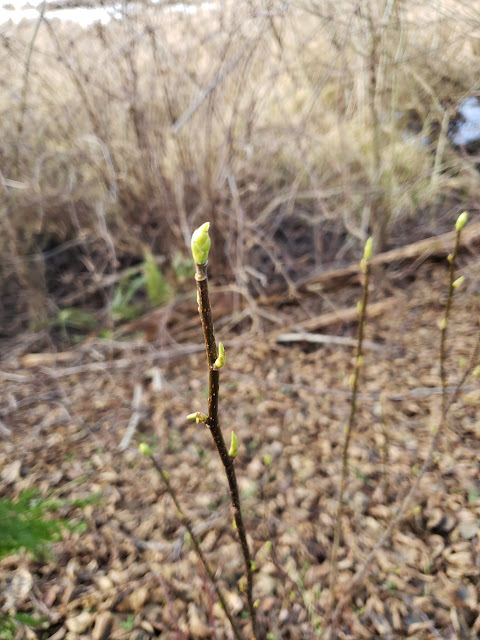It seems I learn something new every day. Actually, I guess that's a good thing.
Today's walk covered some of the same route as that of the "Strange Weather" entry of a couple days ago. As I neared the spot where I took the photo of the unidentified bush that was first in my previous blog entry, I saw there was a wetlands restoration volunteer taking cuttings off that same bush. In response to my question, he told me it was an "Indian Plum" and that he was taking cuttings to make new starts for other restoration projects.
Here's a partial description from the USDA Natural Resources Conservation Service Fact Sheet:
Osoberry is a frequently used common name while Oregon plum, Indian peach, and bird cherry are also synonyms. Often the first deciduous native shrub to flower in late winter, Indian plum is an important early season nectar source for hummingbirds, moths and butterflies, native bees and other pollinator species. Indian plum is popular for Pacific Northwest restoration projects due to its ease of propagation, rapid growth, and wide tolerances for various shade and moisture regimes. The fibrous roots resist erosion. Clones that root more readily can be employed in restoration projects as live stakes or as rooted cuttings. With adequate sunlight, it bears numerous late winter/early spring flowers from a young age but root sprouting may limit its landscape use to larger settings. Various small mammals plus foxes, coyotes, deer, bears, and many bird species consume the ‘plums’ and disperse the seed. For livestock, this species is considered unpalatable. Indian plum fruit is edible for humans but is often bitter, even when fully ripe. Native Americans ate the fruit fresh, dried, or cooked. The bark was used as a tuberculosis remedy and a mild laxative. Strips of bark were used to bind harpoon tips.
Farther along I saw another rose in bloom with many buds. In the first photo, I was experimenting with the "selective focus" setting on my smartphone camera. The photo below is of the same rose with the regular settings.
Here's a photo of the Rosemary hedge I mentioned in the previous entry. It's difficult to see in this photo but the upper part of the hedge is covered in blooms.
In the entry made on 12/21/20 I was discussing the various forms of twilight and the various speeds of the Earth's rotation, depending of location between the pole and equator. It entered my mind that, because of centrifugal force, we should weigh less at the equator than at the poles.
The NASA website confirmed that suspicion, although the difference isn't much. If you weighed 100 pounds at the pole, at the equator you would weigh 5.5 ounces less due to centrifugal force.
The effective acceleration of gravity at the poles is 980.665 cm/sec/sec while at the equator it is 3.39 cm/sec/sec less due to the centrifugal force. If you weighed 100 pounds at the north pole on a spring scale, at the equator you would weigh 99.65 pounds, or 5.5 ounces less. (gfsc.nasa.gov)
I also should make clear that when I said you aren't moving at the pole, that referred only to the speed of rotation of the Earth, not the various other speeds that we are part of. We are traveling around the sun at about 67,000 mph. The sun (and the rest of our solar system) is traveling 514,000 mph around our galactic center. Our Milky Way Galaxy is traveling at about 1.3 million mph.
It's a little difficult to answer the question, "How fast am I traveling while sitting watching TV in my living room?" I'd start with the Galactic speed, but that would be accurate only when our solar system was either in the 12 o'clock or 6 o'clock position in relation to the galactic direction of travel. If our sun were at the 3 o'clock position, we'd need to subtract 514,000 mph from the 1.3 million, and if the sun were in the 9 o'clock position we would need to add that same 514,000 mph. We would need to make the same calculations regarding the Earth's speed (67,000 mph) and position around the sun.
Then there is the unanswered question of whether, besides expanding, our universe is traveling (and how fast) in relation to possible other universes or whatever might exist external to our universe.
Sort of mind boggling, isn't it.


















